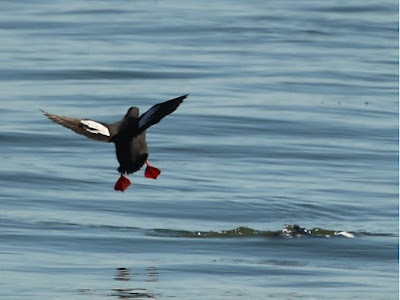Monday 10 June 2024
 |
| Redshank - Normandy Marsh |
For many, a mention of Hampshire's New Forest will conjure up images of pony-dotted open heaths and magnificent mature woodlands. But birdwatchers will know that it has a hidden side of equal value for wildlife - its coastline.
From Keyhaven in the west to Lymington's busy yacht marina in the east stretches an unbroken chain of grazing marshes and lagoons that are of exceptional value for birds. Happily, it is all managed for conservation: 200 hectares of land within the sea wall forms Hampshire County Council's Lymington-Keyhaven Nature Reserve (link to a pdf of their leaflet here), while an even larger area of adjacent mudflats and saltmarshes are leased by the Hampshire and Isle of Wight Wildlife Trust - more information here). Even better, the area is well-served by public footpaths, including the Solent Way long distance trail.
These coastal wetlands have proved to be a happy birding destination for me in previous years (one visit notably producing two species of phalarope). Today I was lured across the Dorset border by news that a pair of Roseate Terns have nested at Normandy Marsh. This is exceptional: I have seen the species on the Northumberland coast (actually on the Farne Islands rather than their Coquet Island breeding stronghold), but it is extremely unusual for them to breed on the south coast. It's not unprecedented: as late as the 1980s and 1990s there have been nesting attempts on the Solent; Langstone Harbour and in Dorset (Brown & Grice, 2005). But the species remains in decline. This was certainly worth a look.
Obviously, there is valid sensitivity about publicising the location of rare breeding birds. Roseate Tern is a protected species (Schedule 1 of the Wildlife & Countryside Act 1981), which means that it is an offence to intentionally disturb these birds while they are nesting. But in this case, the news has been made public (for example here). It helps that the site is protected by fences (electric and barbed wire) and is subject to 24-hour monitoring. (It's sad that this is necessary, of course, but that's a different story). A number of other birders were around during my visit.
What's good for the birds is not necessarily good for the photographer, of course. I have no patience at all with those camouflaged camera-wielders who are happy to disturb birds just to get a good picture. At Normandy Marsh, the Roseate Terns are nesting in a colony of Black-headed Gulls and Common Terns located on on island in the middle of the lagoon. This stretched my camera lens to the limit, so here's a rather distant record photo. It's good enough to show the key field marks: a black bill and very pale upperparts. I couldn't make out any pink flush on the breast or belly.
%20Normandy%20Marsh%2010.6.24.JPG) |
| Roseate Tern (record photo) - Normandy Marsh |
Fortunately, there were closer views of other birds, including a Little Tern which ignored me completely as it flew past the sea wall hunting for fish in channels through the mudflats. Another, or the same bird, flew over the Common Tern colony a short while later. I'm not sure where the nearest Little Tern colony is, but they certainly breed in the area of the Solent.
 |
| Little Tern - Normandy Marsh |
 |
| Little Tern - Normandy Marsh |
From the sea wall, it was possible to get good views of other breeding birds on the marsh - all on the other side of the fence. This included a family of Avocets. Can you spot the two chicks?
 |
| Avocet family - Normandy Marsh |
There were good numbers of Avocets on the marsh; the post-war recovery of the species in the UK has been a huge conservation success story.
 |
| Avocet - Normandy Marsh |
The Avocets were vocally, and physically, defending their young from anything that came close, including a Redshank which was briskly chased away. While this is an innate response to any perceived threat, the Redshanks are unlikely to do serious harm to the Avocet chicks. In fact, they were too busy trying to look after their own youngsters, which were larger than the Avocet young and straying widely. As a result, the adult Redshanks were more mobile, and considerably more vocal, than the Avocets. Several perched on, and called from, the fenceposts surrounding the lagoon (below and photo at the start of this post). It was time to leave them to it.






%20FFO%20Alcatraz%20I%20CA%2013.4.23.JPG)









